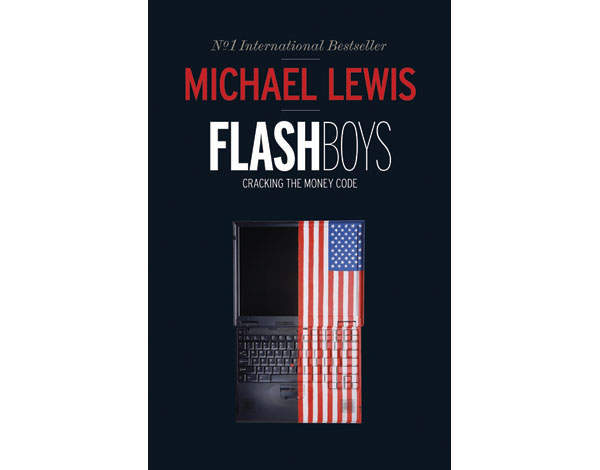

Flash Boys: Cracking the Money Code
Michael Lewis
EX LIBRIS
A Michael Lewis book is an event. Flash Boys, about high-frequency trading (HFT) on Wall Street, was greeted by headlines on both sides of the Atlantic and caused various US regulatory authorities to announce that they already had investigations under way.
This is not the first book about HFT — that was Scott Patterson’s Dark Pools (which I reviewed for these pages in November 2012). Patterson began his story in 1996, with the creation of the first trading system to bypass market makers, and covered the ensuing ‘algo wars’ (named after the algorithms that came to dominate trading). Dark pools, the opposite of ‘lit’ markets, were private exchanges within the big banks through which those banks would buy and sell stocks on behalf of their clients.
Lewis starts in 2007 and focuses on three storylines: the secret building of a fibre-optic network from New Jersey to Chicago, the inadvertent theft of some HFT code by a software engineer at Goldman Sachs and one man’s crusade to reintroduce some fairness into a system that had become rigged.
A Wall Street outsider, Brad Katsuyama worked as a trader for the Royal Bank of Canada. In the spring of 2007 he realised that when he sought to execute a trade at a quoted price, the price rose before his order could go through, and vice versa when he sought to make a sale. Robot machines, he concluded, were engaged in the ancient and illegal practice of front-running.
With advance knowledge of pending orders, a stockbroker would execute orders on his own account and generate an easy profit on the trade while assuming no market risk. High-frequency traders were even able to front-run the banks from inside their own dark pools, so the banks started to charge them for the privilege.
This situation had arisen because in 2007 the Securities and Exchange Commission had implemented the Regulation National Market System (Reg NMS), requiring all brokers to seek the best possible price for their customers. At the same time, it had deregulated the stock exchanges to generate greater competition.
Suddenly there were thirteen fully automated exchanges instead of just two. The speed at which one could place an order became a critical issue and Wall Street players were prepared to pay for even the most minuscule enhancements in speed.
Seeing an opportunity here, a start-up called Spread Networks decided to spend $300 million laying a fibre-optic cable in as straight a line as possible (since bends slow the signal) along the 837-mile route from Chicago to New Jersey, drilling through the Alleghenymountains of Pennsylvania as they went.
Straight away, Wall Street banks started paying millions per annum each for access. At the same time the HFT firms paid to have their computers placed inside the exchanges, adjacent to the computers that matched buyers and sellers (the matching engines), as the closer the computers, the faster the transaction.
HFT meant that Wall Street was no longer a level playing field. ‘The US stock market was now a class system, rooted in speed, of have and have-nots,’ Lewis explains. ‘The haves paid for nanoseconds; the have-nots had no idea that a nanosecond had value… What had once been the world’s most public, most democratic financial market had become, in spirit, something more like a privateviewing of a stolen work of art.’
Katsuyama’s response to this insight was to assemble a team of oddballs who developed and sold a software system called Thor. This routed orders so as to avoid front-running, but when it proved to be too narrow in its application Katsuyama’s team created a new exchange called IEX, which located its matching engine at a point 350 microseconds away from where brokers were permitted to connect to the exchange, thereby creating a delay that would prevent front-running.
That 350-microsecond delay, equal to all-comers, required 38 miles of fibre, but instead of running the fibre from one geographical location to another the fibre was coiled inside a shoebox-sized compartment.
Even Goldman Sachs supported IEX, though only because its own HFT team was being outclassed by the HFT firms — a realisation that combined cynicism and humility.
The heroes of this tale are Wall Street insider-outsiders, backroom boys, who are either recently immigrated science graduates or telecoms experts from blue-collar backgrounds. They are different from Wall Street traders and bankers but nonetheless have little understanding of the moral implications of their daily work until Katsuyama helps them share his insight.
They find a new meaning in their lives, as does Sergey Aleynikov, the Russian software geek who was initially sentenced to 97 months in jail for taking some of his own HFT code home from Goldman Sachs — he actually wanted it as a souvenir — until his conviction was quashed.
Presumably because they’re so damned secretive, Lewis never got to interview an executive at an HFT firm. Hence the positive case for HFT, that it helps to raise liquidity and lower spreads, is only advanced rhetorically. This is a minor quibble, however.
A practised storyteller, Lewis is equally good at putting human faces on money men as he is at explaining technically abstruse matters in layman’s terms. In Flash Boys he champions a misfit element of Wall Street’s junior officer class who have come to believe that the interests of the ordinary investor should be on a par with those of the professionals who serve them.
Read more book reviews from Spear’s






